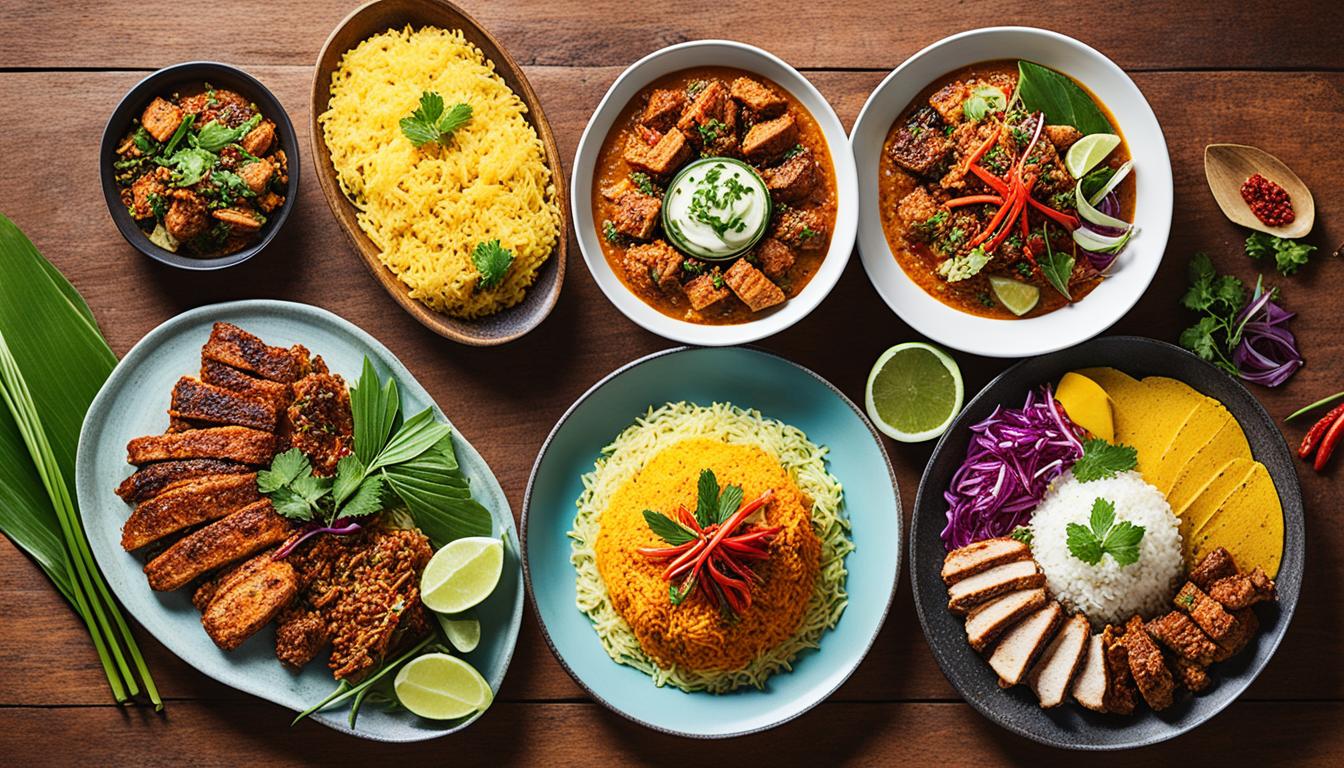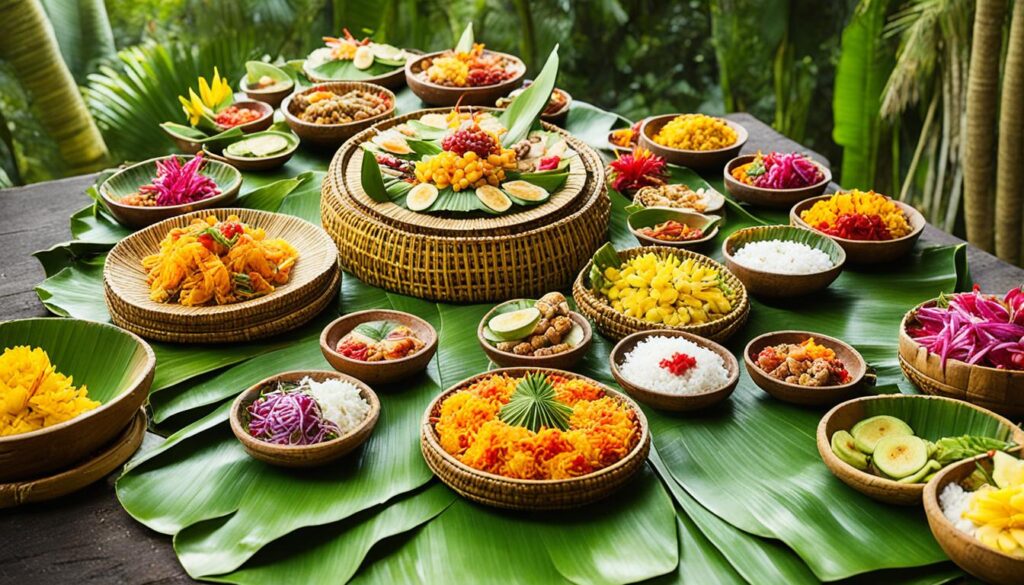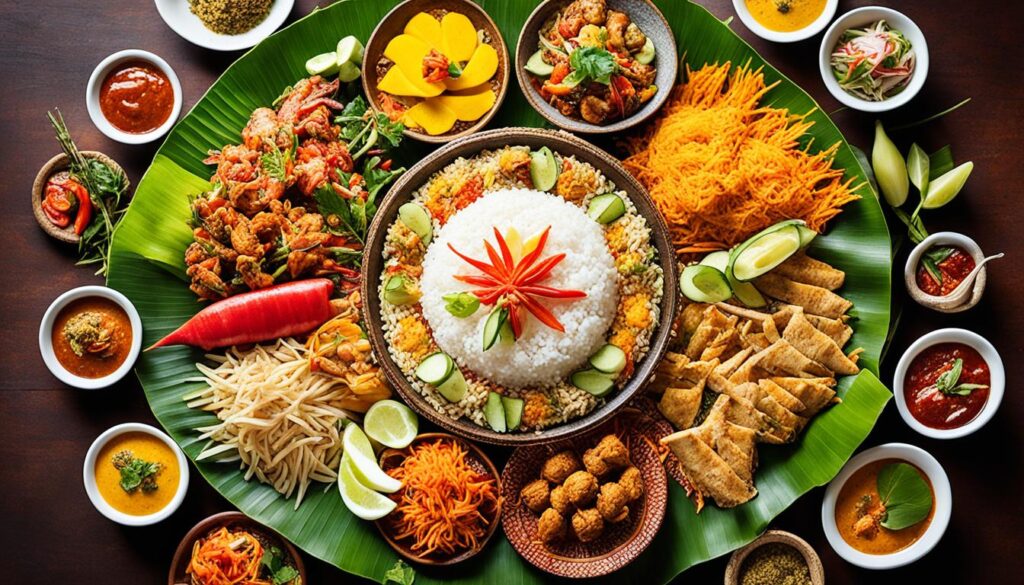
Delight in Balinese Cuisine: Flavors of Indonesia
Step into Indonesia’s heart with Balinese cuisine. It’s a flavorful treasure reflecting the island’s rich culture. Traditional dishes tell stories of history, community, and culinary skill. Explore the deep taste profiles of authentic Balinese food, where each bite shares the island’s traditions.
Balinese cuisine is famous for its spice, complexity, and depth. It combines local traditions with global influences. Dishes like the smoky Babi Guling and spice-filled Bebek Betutu invite you to discover Bali’s rich food culture. Each recipe offers a taste of the island’s gastronomic vibrancy.
The Unique Taste of Balinese Culinary Heritage
In the beautiful lands of Bali, there’s a rich Balinese culinary heritage. The island’s cooking is a mix of traditional Balinese flavors. Here, spices like nutmeg and coriander mix with the sharp taste of pepper. Every ingredient and technique is carefully chosen.
The unique flavors of Bali show the local cooking methods that have lasted for years. Balinese cooking techniques create a perfect balance. They include slow roasting, which makes the meat tender, and steaming that brings out the taste in their fruits and veggies. This cooking story is old but keeps changing, giving a unique eating experience.
| Ingredient | Flavor Profile | Preparation Technique | Dish Example |
|---|---|---|---|
| Black and White Pepper | Spicy, Earthy | Used in spice pastes and as seasoning | Lawar |
| Coriander | Warm, Citrusy | Ground for marinades and gravies | Bebek Betutu |
| Cumin | Warm, Bitter | Toasted and ground for rubs | Sate Lilit |
| Nutmeg | Sweet, Pungent | Finely grated for desserts and sauces | Godoh Biu |
| Sesame Seeds | Nutty, Crunchy | Toasted for garnishing | Jukut Antungan |
| Shallots and Garlic | Aromatic, Sharp | Minced for sautés and bumbu (spice mixes) | Nasi Goreng |
| Galangal and Turmeric | Earthy, Pepper-like | Sliced or grated for curries and soups | Gulai Ikan |
| Ginger | Fiery, Sweet | Crushed for marinades and stir-fries | Ayam Tum |
When people try Balinese food, they step into a world full of traditions and love—a world that celebrates Balinese culinary heritage. Every dish is more than just a meal. It’s a heritage, a story from the past, served with Bali’s love.
Spice Islands’ Bounty: The Foundation of Balinese Flavors
The heart of Balinese cuisine ingredients lies in the rich Indonesian spices from the Spice Islands. Nutmeg, cloves, cinnamon, and cardamom are key to a tradition that goes beyond taste. They offer a complete experience for the senses.
The spice trade in Bali has left a lasting mark on the island. It has added depth to both its flavors and culture. These spices have become key to Balinese spice blends, defining the island’s food identity.
“The unique tapestry of Balinese flavors owes its vibrant hues to the singular blends of local spices, where each individual note harmonizes to compose a symphony of taste.”
Balinese spice blends, like Basa Gede or Bumbu Bali, are treasured family secrets. They are more than spice mixes. They carry the heritage and heart of Balinese cooking.
- Nutmeg’s warm essence
- Cloves’ intense aroma
- Cinnamon’s sweet, woody scent
- Cardamom’s complex flavor
These Indonesian spices add unique tastes and health benefits to Balinese cuisine ingredients. Their use shows the Balinese value of balance and health.
Bali’s spice trade has made its food famous worldwide. The diverse spices offer rich flavors that everyone wants to try. Both locals and visitors enjoy the unique taste combinations.
Whether eating street food or dining in fancy places, these spices are key. They bring to life a culinary tradition that welcomes everyone. Their aroma and flavor light up Balinese food.
Indeed, Balinese food and its spices share a combined story. It’s a tale of history, culture, and the pursuit of flavor harmony.
Balinese Cuisine: A Blend of Tradition and Community
In Bali, food tells a powerful story of culture and togetherness. Balinese culinary traditions are deeply rooted in society. They show the soul of the island and how people connect. Exploring food rituals in Bali reveals their importance in daily life and special celebrations.

Ritualistic Aspects of Food in Balinese Culture
In Bali, food is filled with ancient wisdom. Food rituals highlight the island’s deep spirituality. Every meal and offering is a link between humans and the divine. The mix of religion and food is shown in rituals like Melasti. This event uses food as symbols of thanks and harmony.
Communal and Festive Celebrations in Bali
Bali’s festive food moments show the value of community. Festivals like Galungan or Balinese weddings fill the air with delicious smells. Communal feasts in Bali are amazing, turning eating into a shared joy.
| Festival | Significant Dish | Cultural Significance |
|---|---|---|
| Galungan | Lawar | A mixture of vegetables, coconut, and minced meat symbolizing the harmony of the universe. |
| Nyepi | Nasi Kuning | Yellow rice representing prosperity, prepared in silence to honor the day of meditation and fasting. |
| Kuningan | Sate Lilit | Bamboo-skewered minced meat reflects the Balinese skill in merging spices and communal cooking. |
A Culinary Odyssey Through Traditional Balinese Dishes
Bali is more than just a beautiful place. It’s also known for its amazing food, especially Balinese traditional dishes. Each bite offers a look into the island’s heart through colorful flavors and ancient cooking methods.

Famous Dishes: Babi Guling and Bebek Betutu
Two famous dishes are Babi Guling and Bebek Betutu, vital parts of popular Balinese recipes. Babi Guling shows off Bali’s cooking art. Its preparation involves a mix of spices and herbs on the meat before it’s slow-roasted. This method gives a crispy outside and juicy inside.
Bebek Betutu is another classic dish, showcasing traditional slow-cooking. The duck is marinated in local spices, wrapped in banana leaves, and slow-cooked. This process ensures a moist, tasty, and memorable Balinese specialty.
Aromatic Spices in Balinese Cooking Techniques
Balinese cuisine is famous for its aromatic spices. These spices, like coriander, black and white pepper, and nutmeg, are keys to the unique flavors of Balinese food. They help create dishes that are both deeply traditional and new.
| Spice | Characteristic Flavors | Common Dishes |
|---|---|---|
| Black and White Pepper | Sharp, pungent, with a slightly earthy undertone. | Babi Guling, Lawar |
| Coriander | Warm, citrus-like, with a nutty hint. | Bebek Betutu, Sate Lilit |
| Nutmeg | Sweet, warm and rich; a classic spice note. | Nasi Goreng, Balinese Curry |
The role of these spices in popular Balinese recipes is very important. They add authenticity and depth. Many travelers and food lovers go to Bali to try these flavors. This culinary adventure keeps attracting and fascinating them with every tasty discovery.
Experiencing Bali’s Gastronomic Delights: Street Eats to Gourmet Feasts
Start your tasty journey in Bali with everything from Balinese street food to fancy dishes in top Balinese restaurants. As you wander through lively markets or seek out the perfect spot for local food in Bali, you’ll find delightful options for all tastes.
Varieties of Warung Food
Discover the true essence of Balinese cuisine in local warungs. You’ll encounter authentic dishes such as:
- Nasi Goreng: A signature Balinese fried rice packed with taste.
- Mie Goreng: Stir-fried noodles, spiced up with local herbs and veggies.
- Sate Lilit: Aromatic minced meat skewers showcasing the island’s culinary tradition.
Visiting these warungs lets you peek into local daily life. You’ll enjoy a genuine Balinese culinary experience that’s both affordable and delicious.
Where to Dine: Best Balinese Restaurants
For fine dining, Bali presents a wide selection of eateries. They offer both local specialties and global dishes. Take a look at some top spots for where to eat in Bali for a meal to remember:
| Restaurant | Cuisine | Ambiance |
|---|---|---|
| Merah Putih | Indonesian Fusion | Modern and Elegant |
| Locavore | Contemporary Indonesian | Intimate and Artistic |
| Warung Dandelion | Traditional Balinese | Charming and Rustic |
These well-known places serve everything from classic recipes to innovative dishes. They offer excellent service, amazing flavors, and different atmospheres from casual to upscale.
Bali promises an incredible flavor journey, from street food to luxurious dining. Exploring its food scene is essential for any food lover visiting this island paradise.
Conclusion
Starting a Balinese culinary journey is not just about trying new foods. It’s about experiencing Bali’s heart and history. The flavors of Bali offer a mix of textures and smells that comfort and excite. Each dish tells a story from the island’s past, thanks to its traditions and rituals.
Trying dishes like Babi Guling and Bebek Betutu, you learn about Bali’s history, spirituality, and community. You might enjoy a festive meal with locals or a quiet dinner by the sea. Both show how important food is to Bali’s people and its visitors.
Exploring Balinese cuisine is more than just eating. It’s a deep dive into a rich culture that stays with you. From small eateries to big name restaurants, Bali’s food scene is dynamic. It invites you to taste, see, and come back for more. Let the many flavors lead you back to the stunning island of Bali again and again.
FAQ
What is Balinese cuisine?
Balinese cuisine is a part of the tradition from Bali, Indonesia. It’s known for its unique flavors. Traditional dishes show off Indonesian food’s rich history.
What flavors are unique to Balinese cuisine?
Unique flavors in Balinese food come from special spices. These include black and white pepper, coriander, and cumin. Nutmeg and sesame seeds are also important. Shallots, garlic, and other fragrant roots add to the flavors.
What role do spices play in Balinese cuisine?
Spices are key in Balinese food. The island’s spot near the Spice Islands means lots of spices like clove and cinnamon are used. They make the food flavorful and complex.
How is Balinese cuisine connected to Balinese culture?
Balinese cuisine and culture are closely linked. Food is used in rituals and to honor gods and ancestors. It also brings people together through feasts and celebrations.
What are some famous Balinese dishes?
Famous Balinese dishes include Babi Guling and Bebek Betutu. They showcase the unique taste of the region.
What is the significance of street food and restaurants in Bali?
Bali has a lively street food scene. Warungs offer traditional food. Many Balinese restaurants provide a range of dining experiences. They show off local chefs’ talents.
Where can I experience Balinese gastronomic delights?
For Balinese food, try local warungs or top restaurants. Both provide a range of flavors and experiences.
Source Links
- https://en.wikipedia.org/wiki/Balinese_cuisine
- https://finnsbeachclub.com/guides/balinese-food-and-local-delights/
- https://urbandiaries.in/tastes-of-bali-traditional-balinese-dishes/

Leave a Reply